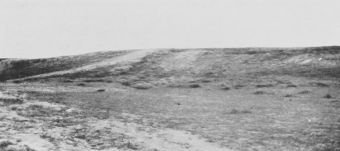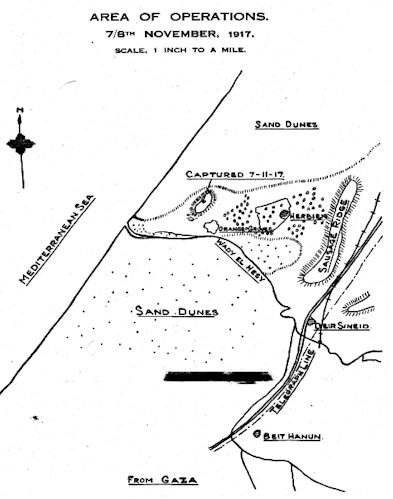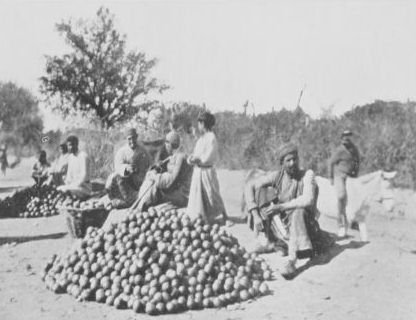|
The 31st brought news of the success of the 20th Corps and the fall of Beersheba. Preparations were made for removal and on the 1st of November the Brigade went into Corps Reserve at Regent's Park. That night the other two brigades of our Division and the 53rd Division went over the top before midnight, and by dawn had taken the whole of the enemy's front and support lines from Umbrella Hill to the sea. In so doing they had bent the seaward end of his defense back on the
town, but he was so heavily echeloned far back along the shore, that it was not until the 7th that a passage could be cleared along the edge of the sea. During those six days the Battalion lay in instant readiness to move. When it did move the Turk was still in Gaza in considerable numbers, and when we were as far north as Esdud we heard that certain strong points in his line were still holding out. He had, however, began his retreat and we knew that what we would have to
deal with would be rear-guards, prepared to sacrifice themselves to the last man to save their main body.
At eleven o'clock on the morning of the 7th the Brigade had been under weigh for an hour and we were tramping over the uneven ground which marked the site of the enemy's old front line, battered out of all shape by seven days' artillery bombardment. The sand was more than ankle-deep and the going heavy in the extreme. The day was hot and steel helmets were never the lightest of head-gear. Still the men marched admirably and by 17.00 the Battalion was at the Wadi Hesi, twelve
miles north of Gaza, where the B.G.C. gave orders to secure the ridges on the other side of the wadi. It was an interesting situation. The Battalion had halted on the shore, on which it had been marching all day, half a mile or so south of the Wadi Hesi. Darkness was falling; the two leading companies ("A" and "B") received orders to move at once across the wadi, turn inland and secure certain small heights which could with difficulty be seen. They were informed that the 7th
H.L.I. would be following to occupy other heights on the left. The companies moved and almost immediately met a cavalry picquet which reported having been driven off our objective, with the loss of their officer, by a large body of Turks. The companies got across the wadi and turned inland just off the shore facing their objective, which was just sufficiently visible for a compass bearing to be taken. The company commanders having got this bearing felt a load taken off their
minds and as it was now quite dark made sure of the disposition of their companies. Soon the advance continued, a hill was reached, but firing from the front indicated that this was not the objective. A patrol moved out under Lieut. Gilchrist, who reported another hill in front held by the enemy. This hill was charged, a deep trench being found a little below the summit; a wounded Turkish officer was captured and one Turk bayoneted, the rest bolted and got clear. Our
casualties in this charge were six. The hill was consolidated; a picquet going into position in front captured a Turk with a rifle almost red-hot. The night was fairly quiet, though continuous rifle and machine-gun fire went on all night, but as the bullets were nearly all going beyond our left we surmised the Turks' next position did not face us. The 7th H.L.I. were now on our left. In the trenches rushed were found bags of oranges and a pot of hot soup, which looked as if
we had effected a surprise.
With the first suggestions of light on the morning of the 8th our glasses disclosed some Turks in a trench which seemed to run away from us and face obliquely to our left. No. 1 and 2 platoons of "A" Company under Lieuts. Sweet and Parr were dispatched to rush this trench, keeping it on their left as they advanced. This was successfully done and the trench entered from the back and the garrison of nine brought back with their arms and equipment and one very hot machine-gun.
The prisoners were big fellows with new equipment and clothing. We had no casualties in this little raid. A picquet was left in the captured trench.
When morning broke we found that we were on our objective all right. In front stretched a wonderful view of a plain studded with orange and lemon groves with fresh green foliage, odd plantations, cactus hedges and a village or two. Immediately below us on our right lay a big orchard with some houses and hidden there were some snipers that worried us a bit and killed a machine-gun officer and Corpl. Kelly of "A" Company. Looking behind we saw the importance of having secured
the hill we were on. It made a perfect observation post for observing the shore, which was now crowded with the remainder of our Division and others just arriving. Unfortunately there was a similar hill on our left which was not assaulted by the troops on our left until some hours after daybreak. We could see Turks on it and soon well-directed shell-fire was sprinkled along the shore. After this hill was taken the fire was indirect and much less effective; our own portion had
only one dose of the enemy's shell-fire, but it was brisk while it lasted and there were a few wounded casualties including Lieut. Tomeny.
In the forenoon it looked as if the Turk might develop a counter attack from the orchard below us, as some 300 Turks were seen advancing in extended order into a plantation about 2000 yards away, but an hour or so later they were seen going back and all sniping stopped. The thick cover afforded by the plantations made it almost impossible to detect movement near us.

Sausage Ridge, Deir Sineid
At 12.30 orders were received from the Brigade to have strong patrols ready to push into Herbieh to cover the right flank of an attack to be delivered by the 155th Brigade against the ridge about 4000 yards south by east of Hesi Summit. This was not necessary, for at 14.45 Colonel Morrison received instructions for an attack on the southern continuation of the 155th Brigade's objective. Attacks of this sort are of necessity quickly arranged, and this resulted in our going
into action without any machine-guns accompanying the infantry, as the enemy's shell-fire had made it necessary to withdraw their mules to cover and there was no time to get them back for the start, nor did artillery fire on either sides play any important part in the coming battle. There was desultory shelling by both sides till darkness fell, but we felt sure that neither side suffered any casualties from that source.
From our position the ridge, known afterwards to the Battalion as Sausage Ridge, was a crest line, quite four thousand yards away, with orange groves and undulating country between, thickly sown with enemy trenches, just newly evacuated by the Turks. The 5th A. & S.H. were to attack on our immediate right, and the 6th H.L.I. to deliver a converging attack from the south-west. The ridge was to be carried as soon as possible, and packs were dumped to make the moving lighter.
The frontage of each battalion was approximately 400 yards and a tree marked the centre of our objective. The bearing was 113° and as the tree disappeared almost immediately after the attack was launched, the advance was compass-directed. As we stood, the objective appeared to be a slight height just beyond a low saddle in a nearer ridge of hills. Behind this ridge ran the main road from Gaza northwards, and it was certain that the enemy would defend it desperately.
"C" and "D" Companies were in the firing-line and at 16.00 the men dropped down through the orange groves of Herbieh, pulling the ripening fruit as they passed, and made rapidly for the distant ridge. Before they were half-way across the level ground darkness had set in. The Argylls on the right were directing but the 155th Brigade on the left was completely out of touch. Firing could be heard from their direction and, as a matter of fact, they had enough to do to hold up an
enemy attack on their left from Askalon. At 17.15 the enemy on our own front opened a very heavy fire from rifles and machine-guns, and, as we drew nearer, he began to put up flares in large numbers. It was impossible to keep in touch with Battalion Headquarters, and the conduct of the attack and the use of reserves had to be decided by the officer in the front line. Thus it was that both the reserve companies were put into the fight before any orders could be received from
Colonel Morrison.
The configuration of the ground constituting the immediate objective was afterwards ascertained to be very different from what it had appeared to be when viewed from a considerable distance in the gathering darkness. Instead of a long unbroken ridge our attack fell upon an isolated mound lying in the centre of a decided indentation on the main ridge. In the first charge the Battalion carried this mound and that part of the ridge immediately behind it with the bayonet. Further
progress was impossible owing to machine-gun fire from defiladed positions on the main ridge, while bombs and rifle grenades were freely used by the enemy. Our men were able to hold on to the mound and make an effort at consolidation, assisted by the Argylls, but they were soon forced back from the portion of the ridge which they had occupied. They fell back to a slight nullah where they were rallied and hurriedly reorganized. A second advance and their bayonets retook part
of the ridge, but only to be driven off again. Another time and yet another did they return and capture the ridge, only to find it untenable. Then Major Findlay decided that it was useless to make a further attempt and that it was better to hold on to the mound which had been to some extent consolidated and try to establish a line running N.N.W. from it. But the enemy pushed his machine-guns forward and concentrated all his fury on our precarious position, which he enfiladed
from the left and left rear. Gradually its defenders were driven westwards along the west of the mound into the depression behind, where they rallied and re-formed, and from which they retook the position. After a game effort to hold on they were once more compelled to retire. By this time the fog of battle had enveloped everything. Major Findlay and Captain Townsend were dead on the top of the hill. Major Brand and eight other officers were out of action; 190 men were dead
or wounded. The remaining officers decided that it was useless to make any further attack and withdrew to Battalion Headquarters with the remainder of the men. The Argylls and the 6th H.L.I. continued to hold a line farther south on the ridge, but out of immediate touch with the enemy. The Turks still continued their heavy rifle and machine-gun fire but made no attempt to advance. At midnight their fire ceased entirely and shortly afterwards the 7th H.L.I. relieved our
Battalion, which moved back to a bivouac area near Herbieh.

Area of Operations.
7/8th November, 1917.
Scale 1 Inch to a Mile
This was the most severe of our night attacks and the most costly. There must have been many individual acts of gallantry but the most outstanding feature of the operations was the collective grit, determination and bravery of the Battalion. Looking at the position next day, with our dead lying where they fell, one wondered how any human valor could have sufficed to capture it, and that not once but four times. There was none of the glamour of leadership about this fight. In
the pitch blackness every man had to lead himself and it says much that all led enemy wards.
A day's rest, and the Battalion was rear-guard to the Brigade as far as el Butani, where the 5th A. & S.H. and the 7th H.L.I. were set to clear the enemy from their positions on the ridges south-west of Esdud. The 6th H.L.I. were in support and our Battalion was not called upon. Next day was Sunday and Colonel Morrison spent the day in reorganizing the Battalion into two companies; No. 1 company being commanded by Captain W.L. Buchanan and No. 2 company by Captain R.H.
Morrison, while six Lewis guns went into battalion reserve. The Australian Mounted Division were at Esdud next day and their innate love for chickens caused a large picquet of the battalion to be sent into the town to preserve order. The picquet squatted on the public square, gazed at solemnly by bearded and unclean descendants of the Philistines and unmoved by the rustlings and stifled laughter of hidden females. The town itself is almost certainly built on the site of the
ancient Ashdod, one of the Philistine strongholds, but, if the architecture of the houses lends color to the story of Samson's pulling down a temple, it also makes it apparent that Goliath must have had great difficulty in finding a lodging. No house in Esdud could have afforded shelter for more than three quarters of him.
For three days the Battalion remained at Esdud and on the 12th moved out against Yebnah. On the march signs were multiplying to assure us that the enemy was not standing upon the order of his going, but this day we expected to get into touch again. There is a long, low line of hills running north and south through Katrah and Mughair to Zernukah, and here the enemy stood to guard the road to Ramleh and his lateral communications to Jerusalem. The Battalion was fortunate for
Yebnah fell without a shot. Not so fortunate the 155th Brigade, for they had a very stiff day's fighting at Katrah, and only the arrival of the Yeomanry Division enabled them to carry the position. However by 16.00 the Turks were again in flight on the road to Jaffa. At Yebnah the Battalion remained for five days, holding an outpost line. From the roof of a house, which was our observation post, we could see the gleaming white tower of the monastery of Ramleh, and could hear
the sound of its bells. The natives of Yebnah had oranges and figs for sale but they did not appreciate the fixation of prices, and their admiration for Colonel Morrison, their first Christian governor for six centuries, was tempered by their love of profiteering, now impossible of fulfillment. It was in this town that the Colonel gave orders to the omdeh or provost for the production of all arms held by the inhabitants. In about an hour some forty of the male population
paraded at Battalion Headquarters in proud possession of the most suicidal collection of converted gas-pipes that the eye of man ever beheld. Abraham might have used them on the plains of Mamre. There were guns seven feet long, there were guns which might have been fired in the days of the owner's grandfather, but there was no gun which would not have been infinitely more dangerous to the firer than to the target. Of modern rifles, Turkish or British, there was none. They
were probably too deeply buried to be dug up at half an hour's notice.

Orange Sellers, Mejdel
At 10.30 on the morning of the 18th the Brigade moved northwards along a road strewed with the jetsam of a retreating army, until Ramleh was reached. Here a bivouac area was taken up in an olive grove but after three hours' halt, orders were received for an advance on Ludd, the ancient Lydda. We arrived at 19.00 and bivouacked beside the road about half a mile south-west of the town.
The Fifth Battalion, Highland Light Infantry
The Fifth Battalion, Highland Light Infantry in the War 1914-1918 |
|